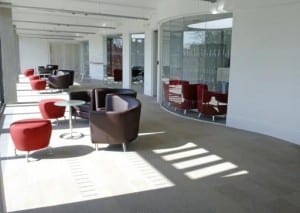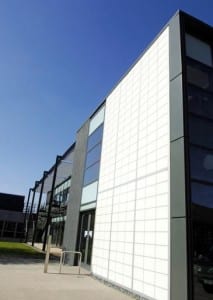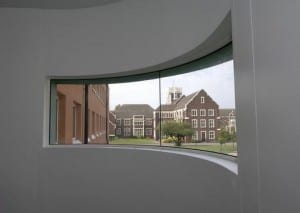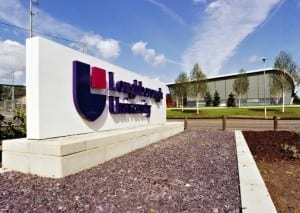University of Loughborough: engCETL building
Innovation

EngCETL interior
The Focus of the case study at the University of Loughborough is the engCETL (Engineering Centre of Excellence for Teaching and Learning), which is located on the first floor of the Keith Green Building at the university’s West Park campus. The engCETL was a £1.6 million project, funded by HEFCE as part of £315 million HEFCE funded initiative to create seventy four Centres for Excellence in Teaching and Learning across the higher education sector. The engCETL is a member of the East Midland’s CETL Network, which is made up of nine other CETLs across the region. The aim of the network is to highlight and reward innovative approaches to teaching and learning, the development of pedagogy, and the sharing of good practice across the east midlands region and nationally.
The engCETL aims to further develop the university’s links with industry by producing employable graduates who are innovative, entrepreneurial and productive. The space aims to achieve this by enhancing the teaching and learning experience at the university – creating a student-centered teaching and learning environment, which encourages the development of independent thinking, innovation and enterprise amongst its undergraduates in the Faculty of Engineering.
The space is comprised of a main reception area, a large design studio and four breakout rooms. The space can facilitate the more traditional didactic approaches to teaching and learning, such as lectures and seminars, or alternatively, it can be arranged to support an environment where students can work collaboratively on group-based research projects, either with, or without, the supervision of the tutor.
The engCETL is a multipurpose space, which is used for various events including internal and external conferences and workshops. However, the engCETL is a priority teaching zone, with students and staff having first call in terms of booking the design studio and breakout rooms during teaching hours in term time.
The space is equipped with high specification technology, such as fixed PCs, projectors, interactive whiteboards, and is Wi-Fi networked so that students can use laptops and handheld technology. Although the engCETL is student- centered, it falls short of providing students with complete freedom of how they can use the space, for example, eating and drinking are prohibited, although there is a café nearby if students want to take a break from their work.
As a Centre for Excellence of Teaching and Learning, there is a commitment by the university to support research and evaluation of the space and the approaches to teaching and learning that it encourages. Academic research has been conducted to evaluate how the space is used. This process is also enhanced by working closely with the Higher Education Academy Engineering Subject Centre, which helps to disseminate and share good practice in teaching and learning.
Mission and Vision

EngCETL Exterior Loughborough
The University of Loughborough can trace its historical roots back to 1909 when it first opened as a Technical Institute. Since this time, it has gone through a series of amalgamations – incorporating a number of teaching colleges before finally receiving university status in 1966. The university has a long history of teaching and learning, most notably, in the subject areas of sports, the arts, teacher education, and industrial training.
Today, the university sees itself as being a ‘well rounded’ institution, with a strong focus on both teaching and research, and, as such, is committed to maintaining excellence in both areas. A key element of this is the university’s vision to further develop its international research profile, and enhance its reputation as a leading university in the UK. Although some academics at Loughborough feel there is an overemphasis on the role of research at the university, teaching and learning is held in equal regard by Senior Managers, and is a significant part of the university’s activities.
The university’s motto is ‘Veritate, scientia, labore’, which translated means ‘With truth, knowledge and industry’, accurately encapsulates the university’s vision to be a key player in influencing economic and social developments of individuals, business, professions, and communities. Loughborough has strong links with industry, including close connections with a large number of world leading companies. These links are further strengthened by the fact that most of the university’s undergraduate degree programmes include a placement year, providing students with the option to work in a business or industry that is related to their degree.
In terms of teaching and learning, Loughborough has been voted one of the top five universities in the National Student Survey, ranked amongst the top six universities in the UK in university league tables, and has recently been voted University of the Year in the Sunday Times (2009). Interestingly, the university has achieved this level of success by following a more traditional model of teaching and learning: ‘We don’t do funky and radical, but we are doing well despite that’ (Senior Academic). In addition, there has been a history of underdevelopment of teaching space at the university ‘nobody knew why our teaching space was poor; the answer is we never invested in it’ (Senior Manager).
More recently, there has been a detectable change of culture at the university and there is now a move towards the development of more innovative teaching and learning space. This change has been partly driven by the university’s corporate strategy, which sets out the significance of the development of the university’s physical environment to support academic freedom and scholarship for students and academics. This has resulted in the development of innovative teaching and learning spaces across the campus, which includes refurbishing the entrances and corridors in some of the academic buildings so that students can work collaboratively on group projects, and the development hi-specification bookable spaces for students to engage in collaborative group work. The engCETL has been both a catalyst and inspiration for these developments.
Leadership and Governance

EngCETL Window
The university has a hierarchical organisational framework, with its senior governing body having ultimate responsibility for the management of the university and financial decision making. This process is supported by the university’s committee structure, which plays a crucial role in the university’s decision making processes and creates a sense of collegiality amongst staff and students. The committees are supported by a series of related sub-committees and working groups that can examine issues in detail, allowing the main committees to concentrate on other business until either the sub-committee or working group reports back its findings. The development of the university’s organisational structure is supported by its corporate strategy, which states that one of its operational principles is to ensure an efficient and effective infrastructure, which has transparent decision making at all levels.
The university has a teaching and learning committee which convenes twice a year to discuss pedagogical developments and highlight the priorities for the improvement of teaching and learning spaces. This process is to be further developed by creating a closer link between the Teaching and Learning Committee and the Estates Committee: ‘Estates and Teaching and Learning tend to report up different routes and they don’t necessarily engage in dialogue, so we are looking at how we can develop this into a good long term governance structure’ (Senior Manager).
The university is attempting to systematically link the development of its teaching and learning space with its corporate strategy and capital spending programme. As a consequence, ideas about the development of space are no longer ‘haphazardly generated’, but are linked to a more holistic way of thinking that reflects the central orientation of the university. This is overseen through the university’s committee structure, which is effective in recognising gaps and disseminating good practice in space planning. This is further supported through the university’s annual reviews, periodic programme reviews and by two dedicated individuals, whose job it is to identify and share good practice in space design.
Crucial to the development of teaching and learning space at the university has been individual ‘go-between leadership’, which has been key in linking academics and the estates department. This individual ‘go-between leadership’ has allowed an informed dialogue to take place between academics and estates, which has resulted in the development of innovative teaching and learning spaces. One example of this form of ‘go-between’ leadership is the Director of Change Projects who, working with colleagues from the estates department as well as with academics, has started to conduct ‘walk-arounds’ of the university’s teaching and learning space to get an understanding of how teaching and learning spaces are being used, and how they could be further developed.
However, the problem is that much of this informed dialogue becomes linked very directly to the individual leadership of one person, the Director of Change Projects. The result is that there has been a lack of any strategic processes to align teaching and learning and estates across the campus.
The university recognizes the shortcomings of relying on a model of individual leadership to act as the interface between teaching and learning and estates: ‘A one person governance structure is not a good thing so we are trying to formalize how we get people together to look at what the priorities for teaching and learning should be’ (Senior Manager). Consequently, the university intends to set up a strategic group that will oversee the management and development of teaching and learning spaces and will formalize the link that has been created between academics and estates.
The university has close links with its students, with a clear commitment as part of the operating principles in its corporate strategy to strong student involvement in its committee structures and decision making processes.
Developing the Brief

EngCETL in the Loughborough Campus
The engCETL was part of a successful bid for funding to HEFCE to create a teaching and learning space, which aimed to enhance pedagogical practice and create a professional environment where students could work collaboratively on group projects.
The university identified the first floor of the newly built Keith Green building as the location for the engCETL. This building was already occupied by the Ministry of Defence who use the ground floor of the building to deliver their Defense Technical Undergraduate Scheme. This shared usage of the building meant that any design innovations within the building would be limited to the space occupied by the engCETL as the rooms occupied by the Ministry of Defence were already arranged in a traditional teaching and learning model.
The design process for the engCETL was part of a ‘learning curve’ at the university, which began with the construction of the Innovative Manufacturing and Construction Research Centre (IMCRC) building. The design of the IMCRC building included extensive consultation with stakeholders and was the first time the university had included users in the design process to this degree.
The design of the engCETL drew heavily on the success of the IMCRC project and used a similar process to develop the brief for the project. This was developed collaboratively with academics, support staff, students, estates and professionals from industry. This process involved a number of meetings between the stakeholders and the architects, with the estates department taking academics on site visits to other universities to help them think about how to develop the space.
Crucial to the development of the brief was that the client group was able to dedicate a significant amount of time to working through the various issues that are associated with designing a new teaching and learning space. The result of the time taken to develop the brief was that very few changes were needed to be made to the original brief once the project was initiated.
Key to the development of the brief was the Head of Media Services who was heavily involved in developing the brief and acting as a ‘go-between leader’, relaying information between academics, estates and the architects about the development of the space. This role was challenging role and involved regularly attending design meetings and project meetings to ensure that the vision for the space was fully articulated and communicated clearly to all of the stakeholders who were engaged with the project.
Project Management
The project team did not use a formal methodological approach to project management during the development of the engCETL, but relied on the skills and experience of the individuals involved. This strategy was not only successful in completing the project on schedule, but also helped to ensure that there was good engagement between the project managers and the client group by making the process simple and accessible:
‘We had a good relationship with the project manager. We could just talk to him about how the project was developing, or ask if there was anything we needed. All of this created a very good sense of dialogue, which I think really helped’ (Director of CETL).
Interestingly, the university is in the process of developing a more rigorous approach to project management, which will be based on the PRINCE2 methodology. The rationale for developing a more consistent approach to project management is to support a large number of projects that are currently being developed across the campus.
Research and Evaluation
The university has not conducted a formal post-occupancy evaluation of the engCETL, but research has been conducted on the learning experience of the space. Questionnaires and interviews have been administered to students and staff by an educational consultant about their experiences of the space and what could be done to improve it. This information is shared with project teams across the university so that there is a system of the learning from and disseminating good practice in the design and use of teaching and learning space. In addition, this information is also shared regionally and national through the East Midlands CETL Network, HEFCE and the Higher Education Academy Engineering Subject Centre.
Recent Comments